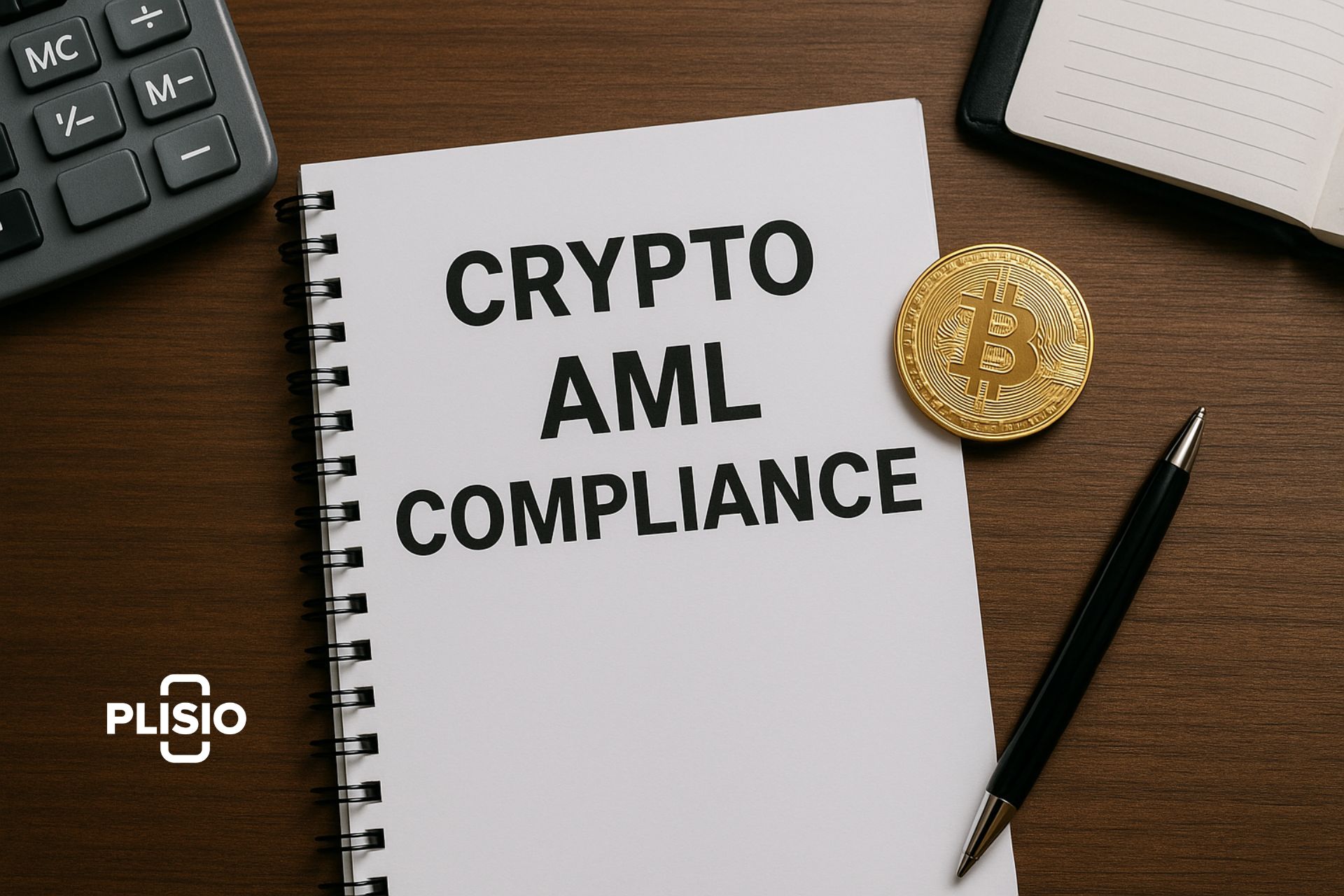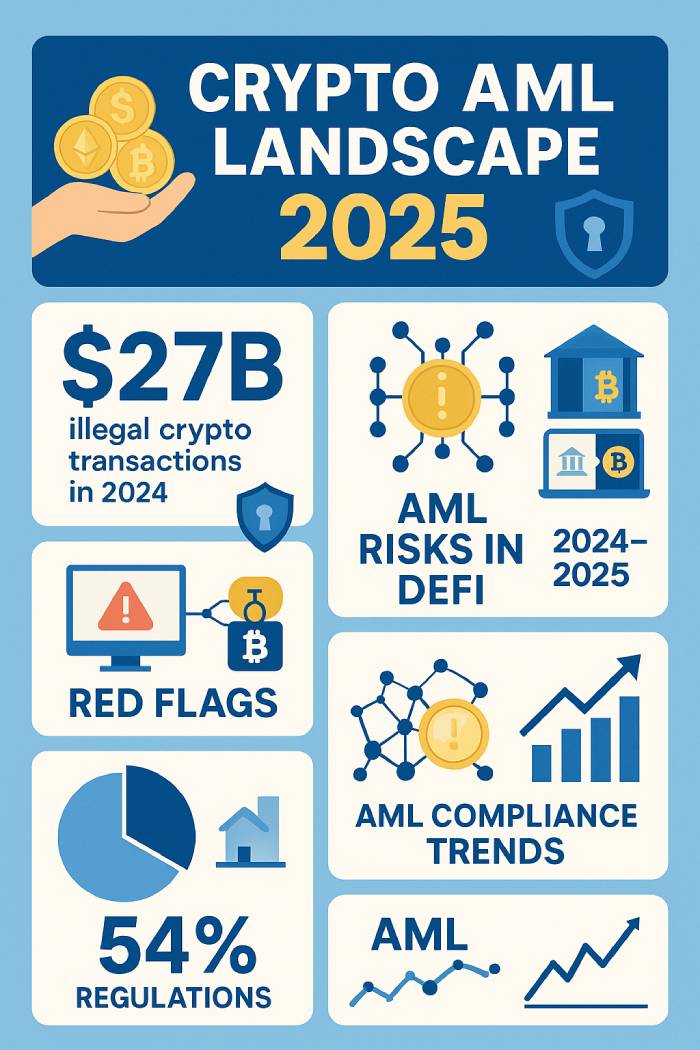AML Compliance in the Evolving Crypto Landscape

Anti-money laundering (AML) represents a global framework of laws, regulations, and compliance procedures designed to prevent criminals from turning illegally obtained funds into legitimate-looking assets. As the crypto industry continues expanding, AML and KYC requirements have become central pillars of responsible crypto compliance. Regulators worldwide now view digital assets, blockchain transactions, and cryptocurrency exchanges as key environments where financial crime, money laundering, and even terrorist financing can occur if proper safeguards are not in place.
AML in cryptocurrency focuses on detecting illicit activities, enforcing verification standards, and ensuring compliance with frameworks established by authorities such as the Financial Action Task Force (FATF), the Financial Crimes Enforcement Network (FinCEN), and other regulators. These efforts all aim to prevent money laundering, secure virtual assets, and strengthen trust in the digital‑asset ecosystem.
Understanding AML and KYC in the Crypto Industry
At its core, AML involves a set of processes that allow financial institutions, crypto firms, and virtual asset service providers (VASPs) to identify suspicious transactions, assess customer risks, and ensure compliance across jurisdictions. Traditional AML practices—built around fiat currencies—now coexist with modern blockchain analytics, crypto transaction monitoring, and identity verification tools.
Because cryptocurrency transactions can be decentralized, pseudonymous, and global in scope, regulators emphasize robust AML frameworks that address these unique risks. Blockchain transparency helps, but criminals still exploit anonymity features and gaps between jurisdictions.
KYC, CDD, and Transaction Monitoring in Crypto Compliance
KYC (Know Your Customer) and CDD (Customer Due Diligence) form the foundation of any effective AML compliance program—whether in traditional finance or in crypto. These procedures help crypto exchanges, wallet providers, and other service providers confirm the identity of users, assess customer risk, and prevent illicit activities.
A strong KYC process includes identity verification via government documents, proof of address, and biometric checks. CDD expands the assessment by analyzing user behavior, risk profiles, and ongoing blockchain transactions.
AML regulations require firms to use continuous monitoring tools that identify suspicious activities in real time. When suspicious transactions occur, VASPs must file reports with law enforcement agencies such as FinCEN.
AML Regulations and the Global Crypto Regulatory Framework
AML regulations for cryptocurrencies gained momentum after regulators realized the risks posed by decentralized currency networks. Since 2014, the FATF has set global standards for crypto AML, influencing national laws and crypto regulations across Europe, the United States, and Asia.
Key regulatory bodies include:
• The Financial Action Task Force (FATF)
• The Financial Crimes Enforcement Network (FinCEN)
• The European Commission
• The Securities and Exchange Commission (SEC)
• The Commodity Futures Trading Commission (CFTC)
Their guidance shapes how cryptocurrency firms implement AML procedures and ensure compliance. Today’s AML frameworks cover everything from crypto exchanges and stablecoin issuers to DeFi platforms and NFT marketplaces.
Why Effective AML Compliance Matters in the Crypto Industry
Effective AML measures protect the crypto landscape from being misused for illegal purposes. Without proper oversight, digital assets could be exploited for money laundering, terrorist financing, and other financial crimes. AML compliance helps crypto businesses maintain their legitimacy, protect customers, and meet regulatory expectations.
Failure to comply with AML laws can result in severe penalties, lost licenses, or even operational shutdowns. For crypto firms, implementing AML procedures is not just a regulatory requirement—it’s a competitive advantage.
AML Crypto Risks: Illicit Activities, Wallet Anonymity, and Blockchain Challenges
Cryptocurrencies introduce risks that differ from traditional financial institutions. FATF and blockchain analytics experts highlight key factors:
• Higher anonymity and pseudonymous wallets.
• Cross-border crypto transactions that bypass traditional controls.
• Lack of centralized oversight in decentralized environments.
• Use of privacy coins and mixers for illicit purposes.
• Ability to move digital assets through multiple wallets quickly.
Criminals often use a common three-step laundering process:
-
Placement: Introducing illicit fiat or illegally obtained crypto into the ecosystem.
-
Layering: Obscuring origins through complex transactions, DeFi swaps, chain hopping, or mixers.
-
Integration: Converting cleaned crypto back into fiat or other assets.
Blockchain analytics tools now help regulators and exchanges identify illicit activities and ensure compliance.

Core AML Requirements for Crypto Firms and Cryptocurrency Transactions
FATF’s guidance defines the global AML standard for cryptocurrency AML. Following these recommendations, regulators worldwide classify many crypto businesses as VASPs. These service providers must:
• Conduct KYC checks.
• Perform customer due diligence.
• Monitor blockchain transactions.
• Report suspicious transactions.
• Maintain AML programs aligned with risk profiles.
• Implement identity verification controls.
• Use blockchain analytics to trace illicit behavior.
Under the Travel Rule—a core FATF requirement—VASPs must collect and exchange sender and recipient information for cryptocurrency transactions above certain thresholds. This rule aligns crypto with traditional financial compliance such as the Bank Secrecy Act.
VASP Definition Under FATF: Virtual Asset Service Providers Explained
A Virtual Asset Service Provider can include anyone engaged in:
• Transferring virtual assets.
• Exchanging fiat and cryptocurrencies.
• Converting digital assets.
• Managing or safeguarding crypto wallets.
• Facilitating digital‑asset financial services.
Individuals like miners who do not control customer assets are not considered VASPs.
Crypto Travel Rule: AML and KYC Obligations for Transactions
The crypto Travel Rule requires exchanges to screen both sides of a transaction, verify counterparties, and ensure that funds are not linked to sanctioned individuals. This ensures AML compliance across borders.
Automated tools help firms:
• Screen customers and transactions.
• Detect AML red flags in real time.
• Track sanctions and PEP list updates.
• Manage jurisdiction‑specific obligations.
Best Practices: The Core Pillars of AML Compliance Programs
Most jurisdictions—including the US and UK—require AML programs to include:
• A dedicated AML compliance officer.
• Strong internal controls.
• Staff training.
• Independent audits.
• Comprehensive risk assessments.
KYC Checks and Customer Due Diligence in Cryptocurrency
KYC includes three key components:
• Customer Identification Program (CIP)
• Customer Due Diligence (CDD)
• Ongoing Monitoring
Automated verification tools streamline onboarding while reducing user friction.
Balancing User Experience With AML and KYC Compliance in Crypto
Some crypto users fear AML and KYC checks reduce anonymity. To maintain smooth user experiences, exchanges use customizable AML software to tailor verification flows to risk levels.
Modern RegTech solutions allow crypto firms to:
• Reduce onboarding friction.
• Prevent fraud.
• Ensure compliance.
With rising regulatory expectations and increasing illicit activity, strong AML programs help cryptocurrency firms maintain legitimacy and succeed in a regulated market.
Crypto AML Statistics for 2025
Recent data from 2025 highlights how rapidly the crypto compliance landscape is evolving:
• Illicit cryptocurrency transactions accounted for an estimated 0.65% of total on‑chain volume in 2024, according to global blockchain analytics reports—down from 0.9% in 2023, showing improved AML effectiveness.
• More than $14.2 billion in illicit crypto flows were identified in 2024, including funds connected to ransomware, darknet markets, and fraud.
• Regulatory enforcement actions increased by 37% in 2024, with FinCEN, the SEC, and the CFTC collectively issuing more than $4.1 billion in penalties tied to AML and compliance violations.
• Over 72% of cryptocurrency firms report using automated transaction monitoring systems in 2025, a major increase from 48% in 2022, demonstrating industry‑wide adoption of real‑time blockchain analytics.
• Travel Rule compliance reached 63% adoption across major crypto exchanges, up from only 25% in 2023, as global regulators tightened requirements.
• Cybercrime groups laundered an estimated $11.8 billion worth of digital assets in 2024, a noticeable increase driven by DeFi exploits and cross‑chain bridges.
• More than 40 countries implemented updated AML crypto regulations by early 2025, aligning with FATF recommendations and increasing global regulatory cohesion.
These statistics illustrate the growing focus on AML compliance, the rising sophistication of blockchain‑based crimes, and the critical need for strong compliance frameworks across the crypto industry.
Real‑World AML Case Studies in the Crypto Industry
Recent enforcement actions underscore the importance of robust AML measures:
• Binance faced multi‑billion‑dollar penalties after regulators uncovered AML lapses and illicit transactions tied to sanctioned jurisdictions.
• Tornado Cash was sanctioned by OFAC due to its use by cybercriminal groups, including Lazarus Group, to launder hundreds of millions through mixers.
• Major ransomware investigations in 2024 recovered over $1.2B in crypto through coordinated blockchain tracing.
These examples reveal how blockchain analytics and AML controls help identify illicit activity at scale.
DeFi‑Related AML Risks in 2025
As DeFi platforms expand, so do AML challenges:
• Automated market makers (AMMs) enable fast anonymized swaps.
• Cross‑chain bridges make tracing funds harder.
• Flash‑loan attacks increased by over 80% in 2024, creating new laundering pathways.
• Decentralized exchanges processed over $1.1T in volume in 2024, much of it unmonitored.
Regulators now place DeFi under heightened scrutiny, calling for risk‑based controls.
AI and Machine Learning in Modern AML Programs
AI‑driven AML systems now:
• Detect suspicious patterns in real time.
• Reduce false positives by up to 40%.
• Score wallet risks using behavioral analytics.
• Automate KYC and customer risk profiling.
By 2025, more than 60% of crypto firms use AI tools to strengthen AML compliance.
Comparison Tables: Traditional Finance vs. Crypto AML
Key Differences:
• Traditional finance relies on centralized ledgers; crypto uses decentralized blockchain.
• Banks have fixed customer identification flows; crypto firms use dynamic KYC with blockchain analytics.
• Mixers, privacy coins, and chain‑hopping introduce crypto‑specific AML risks.
These differences require tailored compliance frameworks.
New Regulatory Changes in 2024–2025
Major updates include:
• The EU's MiCA and AMLA formation, creating unified oversight for digital assets.
• FinCEN’s 2025 Travel Rule update, expanding reporting thresholds.
• SEC and CFTC tightening definitions of crypto securities and service providers.
• Asia‑Pacific jurisdictions introducing stricter VASP licensing rules.
Crypto firms operating globally must adapt to jurisdiction‑specific requirements.
User Experience and Risk‑Based Onboarding
Modern crypto platforms minimize friction by:
• Using tiered verification based on customer risk.
• Offering automated document checks.
• Reducing manual reviews with AI.
• Enabling seamless onboarding for low‑risk users.
This approach boosts compliance without harming user experience.
Crypto AML Outlook to 2030
Experts predict:
• Global Travel Rule networks will reach full interoperability.
• DeFi platforms may be required to implement embedded compliance.
• Stablecoins will fall under stricter transparency rules.
• Wallet‑level identity systems may become mandatory.
AML in the crypto industry will continue converging with traditional financial standards.
Glossary of Key AML Terms in Crypto
KYC: Know Your Customer verification.
CDD: Customer Due Diligence.
VASP: Virtual Asset Service Provider.
Mixers: Tools for anonymizing blockchain transactions.
Chain‑Hopping: Moving funds across multiple blockchains.
Layering: Laundering stage involving complex transactions.
This glossary improves clarity for new and experienced readers.
Cybersecurity as Part of AML Strategy
Cybercrime and AML now overlap more than ever. Strong cybersecurity helps:
• Detect wallet takeovers.
• Prevent exchange intrusion.
• Protect API access.
• Identify malware‑driven fraud.
Many regulators now list cybersecurity controls as mandatory AML requirements.
Sector‑Specific AML Insights
Key laundering sectors:
• Ransomware: Over $1B processed through crypto annually.
• Darknet markets: Down 22% in 2024 but still significant.
• Scams and fraud: Largest share of illicit flows.
• DeFi hacks: More than $3.8B stolen in 2024.
Understanding these threats strengthens AML programs across crypto businesses.



